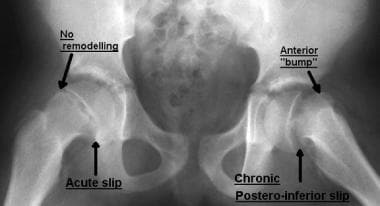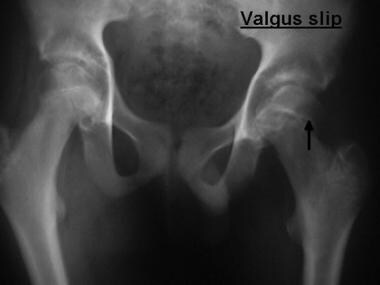Practice Essentials
Slipped capital femoral epiphysis (SCFE) was first described by Ernst Müller, who called it Schenkelhalsverbiegungen im Jungesalter ("bending of the femoral neck in adolescence"). The term slipped capital femoral epiphysis is actually a misnomer, because the epiphysis is held in the acetabulum by the ligamentum teres; thus, the metaphysis actually moves proximally and anteriorly while the epiphysis remains in the acetabulum. [1] (See the image below.)
 Bilateral slipped capital femoral epiphysis. One side shows evidence of remodeling of the neck and an anterior bone bump that restricts flexion. The other side demonstrates an acute slip as seen by the absence of any evidence of remodeling.
Bilateral slipped capital femoral epiphysis. One side shows evidence of remodeling of the neck and an anterior bone bump that restricts flexion. The other side demonstrates an acute slip as seen by the absence of any evidence of remodeling.
In most patients, SCFE appears radiographically as a varus relation between the head and the neck. [2] Occasionally, the slip appears to be in a valgus position, with the epiphysis displaced superiorly in relation to the neck. [3, 4, 5] In the vast majority of cases, the etiology is unknown, though atypical slips may be associated with a known endocrine disorder, with renal failure osteodystrophy, or with previous radiation therapy. [6, 7, 8, 9]
Treatment is essentially surgical. The main principles of treatment are (1) stabilization of the slip to prevent progression and (2) promotion of closure of the upper femoral physis. Although surgery should be performed promptly, it is elective; therefore, any severe underlying medical conditions that would significantly increase surgical risk should be addressed.
SCFE is not life-threatening; however, untreated and complicated SCFE can lead to deformity and early osteoarthrosis of the hip and thus can cause considerable morbidity. Factors that increase morbidity include avascular necrosis (AVN) of the hip and chondrolysis. [10] Both of these may result in damage severe enough to warrant a salvage procedure, in the form of an arthrodesis or a total hip arthroplasty (THA). Prompt diagnosis is critical to prevent further deformity and AVN. [11] The diagnosis is often subtle, and symptoms (eg, groin or knee pain) can be misleading.
Pathophysiology
SCFE develops as a consequence of increased stresses across a weakened physis, with a combination of both biomechanical and biochemical factors contributing to the development of the slip. Factors affecting the stability of the physis include the following:
-
Perichondrium - This is thick in children but progressively thins with age
-
Perichondrial ring - This is a fibrous ring that spans the physeal plate and extends from the metaphysis to the epiphysis; it also thins with age
-
Transphyseal collagen - This weakens because of progressive mineralization; cross-linkage of collagen is affected in osteolathyrism, leading to slippage in these patients
-
Mammillary projections - These assume increasing importance as the perichondrial ring thins
-
Contour of the growth plate - This is normally convex toward the physis with undulations at the periphery, which contribute to its resistance to linear shear and torque forces
-
Thickness of the growth plate - This is mainly affected by biochemical and endocrine factors
Mechanical factors leading to increased stress across the physis [12] include the following:
-
Increased physeal slope - This is an increase in inclination of the physis at the time of rapid skeletal growth around puberty [19] ; patients with SCFE have been shown to have a higher physeal inclination even on the opposite side
-
Deeper acetabula - The mean center-edge angle of Wiberg is higher in children with SCFE than in control subjects; deeper acetabula lead to increased coverage of the femoral heads and increased stress across the physis
SCFE is most common in the peripubertal age group; the effect of the following hormones on the physes may contribute to the likelihood of developing a slip [20] :
-
Growth hormone - This causes widening of the physes and consequent weakening
-
Sex hormones - Increased physeal width and decreased physeal strength result from testosterone, probably accounting for the increased frequency in boys; narrowing of the physis and increased physeal strength result from estrogen, possibly explaining why slips seldom occur in postpubertal females [21]
-
Thyroid hormone - The effect of this hormone is not clear, though it is known that slips can occur in patients with hypothyroidism and those receiving thyroid hormone replacements for hypothyroidism
Even though most children with SCFE do not have an overt endocrinopathy, they may very well have some subtle endocrine disorder. [22, 23, 24, 25] A delay in bone age with respect to chronologic age in some of these children lends further credence to this theory. [21]
Shear stresses across a physis made vulnerable by the biomechanical and biochemical factors outlined above leads to the slip. The displacement is determined by the direction of the deforming force. Posteroinferior displacement of the head (anterosuperior migration of the neck) is the most common pattern, though in rare cases, the head may displace posterosuperiorly, giving rise to an apparent valgus slip (see the image below).
Etiology
Various causative factors for SCFE have been identified. [26] Factors related to body habitus include the following:
-
Obesity - At least 50% of patients are above the 95th percentile for weight [27]
-
Excessive tallness or thinness
If the patient's height is below the 10th percentile, the likelihood of an underlying endocrinopathy is high. [28, 29] Endocrinopathies that may be present include the following:
-
Hypogonadism (adiposogenital syndrome)
Radiation therapy, especially for childhood leukemias or lymphomas, may be involved in the development of SCFE:
-
This cause of SCFE tends to occur in young children
-
Affected children are also light and thus tend to have mild slips
Finally, renal failure is an important factor:
-
There is a high incidence of simultaneous bilateral presentations (~87%)
-
The highest incidence of severe slips is in these patients
-
There are two distinct patient subgroups: those whose disease is controlled early (less hyperparathyroidism) tend to have mild slips, and those with poorly controlled disease (significant hyperparathyroidism) tend to have severe slips
Epidemiology
United States and international statistics
The prevalence of SCFE varies widely even within the continental United States. It has been reported to be 2.13 cases per 100,000 population in the southwestern United States and 10.08 cases per 100,000 population in the northeastern United States [17] ; it is lowest in the mountain and Great Plains states.
In Asia, the reported prevalence has been low, with just 0.2 cases per 100,000 children affected in eastern Japan. [30] A cohort study from South Korea found that the prevalence of SFCE there increased significantly between 2009 and 2019, rising from 0.96/100,000 to 2.05/100,000. [31]
Age-, sex-, and race-related demographics
The mean age at diagnosis is 13.5 years in boys (range, 13-15 y) and 12 years in girls (range, 11-13 y). [18] This corresponds to the period of maximum skeletal growth. Juvenile SCFE (in children < 10 y) should raise the suspicion of an underlying cause (eg, an endocrinopathy). Radiation-associated slips tend to occur in young children.
Males are affected more commonly than females are; the male-to-female ratio is 2-5:1.
A race predilection exists for SCFE, as follows [18] :
-
Whites - 1.0
-
Pacific Islanders - 4.5
-
Blacks - 2.2
-
American Indians and Hispanic individuals - 1.05
-
Indonesian-Malay peoples (eg, Chinese, Japanese, Thai, Vietnamese) - 0.5
-
Indo-Mediterranean peoples (those of Near East, North African, or Indian subcontinent ancestry) - 0.1
Prognosis
If the SCFE is mild or moderate in severity and is maintained between the femoral head and the acetabulum, long-term outcome is good, and AVN and chondrolysis do not develop. Hips with a severe SCFE and those with AVN or chondrolysis undergo more rapid deterioration with degenerative changes and ultimately require reconstructive procedures.
Murgier et al carried out a single-center retrospective study assessing clinical and radiographic outcomes of in-situ fixation for SCFE in 11 hips followed for a mean of 26 years (range, 10-47 y). [32] They found that in moderate-to-severe SCFEs, in-situ fixation yielded poor functional results, substantial hip osteoarthritis, and potential femoroacetabular impingement, whereas with minor displacement, it yielded satisfactory functional and radiographic results. The cutoff point for considering other treatment options appeared to be about 30° of slippage.
Nectoux et al performed a multicenter retrospective study evaluating the clinical and radiologic evolution of 222 hips treated with in-situ fixation and followed for a mean of 11.2 years. [33] In cases of moderate-to-severe initial epiphyseal displacement, in-situ fixation led to hip impingement; however, in cases of lesser displacement, it yielded satisfactory function scores, with no clinical or radiologic evidence of impingement. The threshold seemed to be about 35° of slippage; the authors suggested that beyond this value, other surgical options should be considered.
Bond et al studied long-term outcome scores in 63 SCFE patients and attempted to determine whether there was a threshold level of deformity beyond which outcomes were predictably poor after in-situ pinning. [34] Of the 63 patients, 14% had poor functional outcomes, 29% had intermediate outcomes, and 57% had good outcomes. Patients with a posterior slope angle greater than 40° were found to have a higher chance of a poor outcome.
-
Valgus slip (rare).
-
Frog-leg (Lauenstein) lateral view, showing a mild slip that can easily be missed on an anteroposterior view.
-
Klein line (line drawn along the superior border of the neck intersects less of the capital epiphysis than on the unaffected side).
-
Southwick head-shaft angle (angle between the metaphyseal surface of the physis and the shaft of the femur on a frog leg lateral view). Difference from the opposite side is used to grade the severity of the slip.
-
Bilateral slipped capital femoral epiphysis. One side shows evidence of remodeling of the neck and an anterior bone bump that restricts flexion. The other side demonstrates an acute slip as seen by the absence of any evidence of remodeling.
-
Chronic slipped capital femoral epiphysis showing the extent of remodeling along the anterior neck (arrow).
-
Pin placement (anteroposterior view). A: The entry point must be at or above the level of the lesser trochanter to avoid the risk of subtrochanteric fracture. B: The pin (screw) should be in the center of the epiphysis. C: At least 2.5 threads engaging the epiphysis should be used for a secure hold.
-
Pin placement (lateral view). Arrow shows entry point in the anterolateral cortex.
-
Osteotomies in slipped capital femoral epiphysis (SCFE). A: Subcapital osteotomy. B: Base of the neck compensatory osteotomy. C: Intertrochanteric compensatory osteotomy. Note that the amount of correction increases from subcapital to intertrochanteric osteotomies.
-
Principle of the Dunn osteotomy. Reduction of the slip after shortening the neck to avoid stretch on the vessels and decrease the risk of avascular necrosis.








